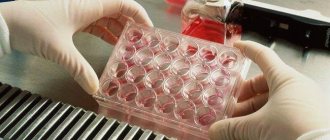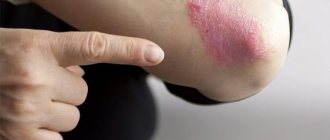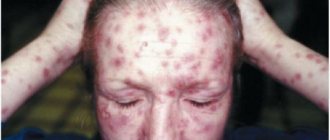10% of patients consult dermatologists with complaints of symptoms of contact dermatitis.[1] They appear in response to the body's immune system to the influence of external irritating factors. It can be:
- detergents;
- dyes;
- decorative cosmetics and perfumes;
- some metals;
- household chemicals, etc.
1-3% of dermatitis are associated with allergies to these substances. Since women come into contact with them more often, they are more susceptible to these diseases[2]. In addition, symptoms of dermatitis are observed in adults who work in chemical production, medicine, hairdressing, as well as in representatives of other professions who have to deal with irritants. According to statistics, 7% of occupational diseases are allergic contact dermatitis[1]. There is another type of this skin pathology – simple contact dermatitis. Both diseases develop according to a similar mechanism, but also have some differences in the course, and therefore require a different approach to treatment. Regardless of what disease the patient suffers from, simple contact or allergic dermatitis, he is prescribed external local remedies in the form of ointments or creams. The type of agent used in treatment is selected depending on the form of the disease (acute or chronic), the severity of the course, as well as the individual characteristics of the patient.
Mechanism and causes of occurrence
The intensity of development and severity of dermatitis symptoms depend on two factors: the activity of the immune system and the strength of the irritant. Thus, the disease can manifest itself after a single interaction with a harmful substance, if it was too aggressive. If the irritant is weak, signs of dermatitis will appear after quite a long contact with it. However, if the human body is very sensitive, an allergic reaction will occur immediately, regardless of the concentration of the irritant.
Based on the body's reaction, you can determine whether the disease is simple contact or allergic dermatitis. If signs appear immediately, limited only to the site of contact with a chemical or physical irritant (friction or scratches), but no other allergy symptoms are observed, we are talking about simple contact dermatitis.[2] Allergic skin disease develops as a result of increased sensitivity of the immune system to a specific pathogen. Contact with it leads to an inflammatory process that extends beyond the affected area. Lesions of the skin or mucous membranes in allergic dermatitis can occur anywhere, since the concentration of the irritant and its route of entry into the body do not play a significant role.[3].
Simple contact dermatitis occurs when interacting with certain substances, as well as under the influence of certain physical factors, such as overheating, compression, squeezing and various injuries to the skin. Most often the disease develops due to:
- kerosene;
- phenol;
- lime;
- acids;
- organic solvents;
- various oils[2].
Not every substance can be an allergen; there are several groups of materials that can cause an allergic reaction in dermatitis. This:
- low molecular weight chemical compounds, metal ions that can penetrate the body through the skin - aluminum, cobalt, chromium and others;
- some medications, both local and for oral administration - antibiotics, anesthetics, agents containing formaldehyde, steroid drugs;
- cosmetics, perfumes and hair dyes that contain alcohol, preservatives and fats;
- rubber products and glue. [3].
In addition, there are plants, contact with which can trigger the development of allergic contact dermatitis. These include representatives of the Asteraceae family - chrysanthemum, poison ivy, primrose and others.
Reasons why contact dermatitis occurs
Contact dermatitis always develops “in the presence” of some chemical, biological or physical environmental irritant. All unfavorable factors that cause a skin reaction in the form of inflammation are conventionally divided into two large groups - obligate and facultative.
To obligate
include factors that irritate the skin of absolutely any person:
- alkaline and acidic compounds;
- poisonous plants, animals, insects;
- ionizing radiation;
- temperatures too low or too high.
Optional
These are the factors that provoke inflammation of the skin only when there is increased sensitivity in a particular person:
- turpentine;
- metal salts;
- some local drugs;
- cleaning and detergents;
- cosmetics;
- synthetic underwear;
- wool clothing;
- formalin;
- machine oil and others.
In addition to the obligatory contact skin irritant, relapses can be caused by the following factors:
- decreased immunity;
- increased sweating;
- intestinal dysbiosis;
- hormonal disorders;
- frequent trauma to the skin;
- chronic skin diseases.
For example, a woman experiences dry and tight skin after using a detergent. But she doesn’t pay attention to this and continues to wash the dishes without household gloves. And one day, dryness and tightness quickly turn into inflammation with itching.
Most likely, in such cases, in addition to an external contact irritant, something else turns on - spring has come, immunity has decreased due to vitamin deficiency, or the day before you cut your finger.
The following point of view is also widespread among specialists: the cause of contact dermatitis should be sought in a violation of autoimmune processes. Due to an autoimmune failure, the body begins to produce antibodies to its own cells. And then any aggressive substance provokes an inflammatory reaction.
Symptoms and signs of the disease
As a rule, at the initial stage the signs of one or another dermatitis are the same. Redness occurs on the surface of the skin, followed by rashes, swelling, dryness and cracks. They often itch, and patients also often complain of a burning sensation and pain in the affected area. Manifestations of contact skin pathology are usually less pronounced, while the allergic form is characterized by more severe redness and swelling. Often liquid-filled blisters appear on the affected area. If they are damaged or burst, this can lead to the formation of large, weeping lesions, which can be accompanied by a secondary infection. In this case, the sites of inflammation will begin to fester, which will lead to a more severe course of the disease and its progression to a chronic form.
A clear symptom of an allergic reaction is skin lesions not only at the site of contact with the irritant, but also on other surfaces. The skin most often exposed to pathogens is the skin of the hands, face, neck, shoulders, collarbones, armpits and scalp. Allergic dermatitis rarely affects the lower limbs and torso.[3].
Dangerous symptoms of dermatitis
If you have signs of contact dermatitis, consult your doctor. The doctor will make a diagnosis and prescribe treatment that will alleviate your condition. You should not hesitate if, along with redness on the skin, signs of infection appear (pus, fever), or if you feel that the mucous membranes of the respiratory tract (it hurts to breathe) or the gastrointestinal tract (it hurts to chew and swallow) are damaged.
To diagnose and treat contact dermatitis, make an appointment with a dermatologist - call +7 (495) 120-08-07.
Treatment of simple contact and allergic dermatitis
Treatment can only be prescribed by a specialist dermatologist after a preliminary consultation and examination of the patient. Depending on the type of skin pathology, the patient may be referred to an allergist, who will study the medical history and assess the nature and extent of the lesion. This is necessary in order to determine the allergen that provoked the disease, since treatment is primarily aimed at partial or even complete elimination of the provoking substance.
Therapy used for dermatoses is divided into supportive and medicinal. The first includes cold compresses, bandages, and antihistamines. Drug treatment is carried out mainly with external topical glucocorticosteroids in the form of ointments and creams.[4] Such drugs have a versatile effect on the source of inflammation, therefore they are the most popular drugs with wide application possibilities.[5] Akriderm preparations are also local glucocorticosteroids.
Diagnostics
Suspicion of contact dermatitis requires a comprehensive examination. The fact is that this disease occurs with symptoms that can manifest themselves in a variety of skin problems. Therefore, simply based on the examination results, it can be difficult to make an accurate diagnosis.
Most likely, the dermatologist will prescribe the following examinations to the patient:
- biochemical skin analysis;
- conducting skin allergy tests;
- analysis for the presence and amount of specific immunoglobulins in the blood;
- stool analysis (to exclude or confirm dysbacteriosis);
- examination of the digestive organs.
In our clinic, all necessary examinations can be completed immediately, on the day of visiting a dermatologist (provided that at least 6 hours have passed since the last meal).
Akriderm preparations for dermatoses
Akriderm ointments and creams are combination preparations that contain several active substances at once, which provide comprehensive treatment for dermatitis of allergic and non-allergic nature. They provide:
- antipruritic effect;
- anti-inflammatory effect;
- antiallergic effect;
- vasoconstrictor effect.[6]
This therapeutic effect was achieved thanks to a thoughtful combination of glucocorticosteroids with broad-spectrum antibiotics and antifungal components. Akriderm ointments and creams not only fight redness, itching and swelling, but also protect the skin from bacterial and fungal infections.
In the fight against contact dermatitis (simple and allergic), it is advisable to use the following Akriderm preparations:
- Akriderm SK ointment contains salicylic acid, due to which it acts quickly and has a favorable safety profile.
- Akriderm GENTA ointment is used for chronic skin pathologies, in particular those complicated by secondary infection.
- Ointment or cream "Akriderm GK" - used for acute and chronic inflammation to suppress unpleasant symptoms
- Ointment or cream "Akriderm" - thanks to the thoughtful concentration of active substances, can also be used for children over 1 year of age.[7]
links to sources
- Contact dermatitis - Clinical guidelines, Russian Society of Dermatovenereologists and Cosmetologists, 2022.
- Dikovitskaya I.G., Korsunskaya I.M., Nevozinskaya Z. Contact dermatitis: clinical picture and therapy // Sovrem. problems of dermatovenerology, immunology and medicine. cosmetology. 2010. T. 4. No. 4. pp. 49–51.
- Stepanova E.V. Allergic contact dermatitis: basic approaches to diagnosis, treatment and prevention // Attending physician. - 2009. - No. 10. - P. 15-19.
- Mercedes E. Gonzalez, “Contact dermatitis” MD, University of Miami Miller School of Medicine.
- Batyrshina S.V. Glucocorticosteroids for local use in the modern strategy for the treatment of inflammatory dermatoses in pediatric practice // Practical Medicine, 2014. No. 9 (85). pp. 94–102.
- Federal clinical guidelines. Dermatovenereology 2015: Skin diseases. Sexually transmitted infections. – 5th ed., revised. and additional – M.: Business Express, 2016. – 768 p. 3. Instructions for use of the medicinal product for medical use Akriderm®. No. Reg. beat LS-002317, R N000663/01.
- Instructions for medical use Akriderm®
Dermatitis. Diagnosis and symptoms
Dermatitis is defined as inflammation of the skin resulting in redness, itching and/or scaling. Contact dermatitis is dermatitis caused by skin contact with a substance. The substance may be an allergen (a substance that causes an allergic reaction) or an irritant (a substance that damages the skin). In approximately 80 percent of cases, contact dermatitis is caused by irritants. In most cases, self-care measures and drug therapy can control symptoms and prevent complications of contact dermatitis.
CONTACT DERMATITIS WITH IRRITANTS
Irritant contact dermatitis occurs when the skin comes into direct contact with a substance that physically, mechanically, or chemically irritates the skin, causing disruption of the normal skin barrier.
Causes of irritant dermatitis
The most common causes of irritant dermatitis are products used on a daily basis, including soaps, cleansers, and rubbing alcohol. People with other skin conditions, dry skin, and fair skin are most at risk, although anyone can develop irritant dermatitis.
Symptoms
Mild irritants cause redness, dryness, fissures (small cracks) and itching. Severe irritants may cause swelling, bleeding, soreness, or blistering. The hands are often affected, often between the fingers. Irritant dermatitis can also affect the face, especially the thin skin of the eyelids.
Diagnostics
Diagnosis of irritant contact dermatitis is usually based on history and physical examination. In some cases, patch testing (applying a small amount of a substance to the skin) may be recommended to determine whether an allergic or irritant type of dermatitis is present. Patch testing should be performed by a dermatologist or allergist trained in this procedure.
Treatment
The goal of treating irritant contact dermatitis is to restore the normal skin barrier and protect the skin from future injury. Reducing or completely avoiding exposure to known irritants is important. In some cases, simply cutting back on soap and using an emollient cream or ointment will completely relieve symptoms. Wearing gloves when working with irritants may also help. Steroid treatment for contact dermatitis is most effective when applied and covered with a barrier, such as plastic wrap, cotton gloves, or petroleum jelly. Oral steroids (such as prednisone) can be used for the short term to treat severe forms of dermatitis, but are not recommended for long-term treatment of irritant contact dermatitis.
ALLERGIC CONTACT DERMATITIS
Allergic contact dermatitis occurs when the skin comes into direct contact with an allergen. This activates the body's immune system, which causes inflammation. Allergic contact dermatitis can occur after exposure to a new product or after using a product for months or years. Mild allergens require several weeks to several months of exposure before they cause dermatitis. The patient can help find the cause of allergic contact dermatitis by providing a history of exposure. For example, if a patient suddenly develops allergic contact dermatitis with blisters, a history of plant exposure is most helpful. In contrast, for chronic allergic contact dermatitis with redness and thickening of the skin, exposure to household items such as clothing, shoes, cosmetics and metals should be mentioned. Common allergens poison ivy, poison oak and poison sumac contain an oil called urushiol, which is the most common cause of allergic contact dermatitis. Ginkgo fruit and mango skin also contain urushiol and may cause allergic contact dermatitis. Other common allergens include nickel in jewelry, perfumes and cosmetics, rubber components, nail polish, and chemicals in shoes (both leather and synthetics). Allergic contact dermatitis can also be caused by certain medications, including hydrocortisone cream, antibiotics creams (sample brand names: Neosporin, Bacitracin), benzocaine and thimerose. Washing powders are a rare cause of allergic contact dermatitis.
Symptoms
Symptoms include severe itching and a red, raised rash. The rash may cause blisters in severe cases. The rash is usually limited to areas that have been in direct contact with the allergen, but the rash can appear in other areas of the body if the allergen has been transferred to those areas by human hands. Washing the allergen with soap and water can usually prevent this spread. The rash usually appears within 12 to 48 hours of exposure to the allergen, although in some cases it may take up to two weeks to appear. Less often, the rash persists for months or years, making it difficult to determine the cause of the reaction.
Diagnosis
Diagnosis of allergic contact dermatitis is based on the person's history and physical examination. If symptoms improve after eliminating the allergen, this confirms the diagnosis. In some cases, an examination may be recommended, usually performed by a dermatologist or allergist.
Treatment
Allergic contact dermatitis usually resolves within two to four weeks after the allergen is removed, although in some cases it may take longer. Certain measures can minimize symptoms during this time and help control symptoms in people with chronic allergic contact dermatitis. If possible, identify and stop any exposure to the allergen. Oatmeal baths or soothing lotions such as calamine lotion may provide relief in mild cases. Topical corticosteroids (steroids) may be recommended for people with mild to moderate symptoms. Steroid creams and ointments are available in different proportions (strengths). For people with more concerning symptoms, moist or wet dressing is recommended, especially when the affected area is oozing and crusting. Such dressings soothe and relieve itching, reduce redness, gently remove crusts and prevent additional damage from scratches. A damp cotton compress (soaked in water and then wrung out) is applied to the affected area and covered with dry clothing. For example, for an adult suffering from allergic contact dermatitis of the legs, wet long underwear may be covered with larger, dry long underwear. Adults may prefer damp underwear at night. When used during daytime, wet dressings should be changed every eight hours. Infants can wear wet pajamas covered with a dry pair of pajamas or a sleeping bag. For people with severe dermatitis, a short course of steroid tablets (such as prednisone) may be recommended to control symptoms. The use of topical antihistamines should be avoided as they may cause contact dermatitis.
LATEX DERMATITIS
Latex is a liquid extracted from rubber trees that is processed into a variety of products including gloves, balloons and condoms. In some people, exposure to these products and others can cause contact dermatitis, which is either an irritant or an allergic reaction. Less commonly, a person may develop a potentially life-threatening allergic reaction to latex.
Irritant dermatitis
Irritant dermatitis usually occurs in people who wear latex or other rubber gloves, but the problem is not the latex. These gloves, whether they contain latex or not, often contain chemical additives that irritate the skin. In addition, gloves trap moisture on the skin, making it softer and more vulnerable to irritants. The combination of these factors can lead to dermatitis. Symptoms of irritant rubber or latex dermatitis include redness and itching of the skin. Dryness and cracking may also occur. People with irritant dermatitis often believe they have a latex allergy and then find that their dermatitis occurs even when they use latex-free gloves. For them, treatment consists of avoiding foods that contain irritants and using an emollient cream or ointment.
Allergy to latex.
A true latex allergy causes a reaction that is different from that seen with irritant dermatitis. A latex allergy can cause hives (increased redness, itching of the skin), irritation or blockage of the nose and eyes, asthma, and even a life-threatening reaction called anaphylaxis. In addition, people with latex allergies often also have allergic reactions to fruits or vegetables that contain proteins similar to those found in latex. These food items include banana, kiwi, avocado, chestnut, papaya, potato and tomato.
Diagnostics.
To diagnose a latex allergy, health care providers learn as much as possible about a person's reaction to past exposure to latex and related allergens. If a pattern is identified that suggests a latex allergy, they will usually confirm the allergy with a blood or skin test. The preferred way to diagnose latex allergy is a blood test. In other parts of the world, diagnosis can be made using skin tests using latex derivatives, but such tests are not as readily available in the United States. The diagnosis of latex allergy is usually made by an allergist.
Treatment.
The primary treatment for latex allergy is to avoid all latex-containing products. Non-latex examination gloves are widely available, and the use of glove liners can also be an effective approach. Instead of latex condoms, you can use natural membrane condoms, which are effective in preventing pregnancy. However, natural membrane condoms do not protect against sexually transmitted diseases such as HIV, gonorrhea and chlamydia. People with severe latex allergies should wear a bracelet, necklace, or similar warning tag at all times. If a reaction occurs and a person cannot explain his condition, it is necessary to provide assistance and provide proper care as soon as possible. This measure is especially important for children. The warning label should contain a list of known allergic reactions and the name and telephone number of an emergency contact. People with latex allergies should inform their doctors, dentists, and other health care providers about their allergy. Some patients are advised to carry an anaphylaxis care kit (containing epinephrine, which can be injected under the skin) with them as a precaution.
No Doctors found! with Name: Rudenko-Polina-Alexandrovna
Sign up for a study at the NEARMEDIC clinic
NEARMEDIC became the first private clinic in the capital to receive the Quality Mark and the Moscow Quality award. In the NEARMEDIC network of clinics, treatment is carried out by experienced immunologists-allergists and dermatologists with specialized qualifications and many years of practice. In clinics you can undergo laboratory diagnostics.
Specialists will conduct a full examination of children and adults, including not only skin tests, but also taking an anamnesis and a full comprehensive examination of the body. This makes it possible to exclude the total effect of different substances or the absence of an allergen in standard test systems. The allergist will select desensitizing therapy and develop a plan of preventive measures. Within 1-3 weeks, the unpleasant symptoms will subside and the treatment will be completed.
To make an appointment yourself or to register your children for an appointment, use the form on the website or call us. We will help you choose a convenient time and answer all your questions.
Causes
The most common causes of the disease are the following allergens:
- Food
- some medications
- pollen and plant sap
- cleaning products (can cause skin irritation even in the absence of an allergic reaction; it is not recommended to use household chemicals without gloves)
- dust
- Pets
- insect saliva
- varnishes, paints
It is important to remember that the causes are not always obvious, so it is important to pinpoint the source before starting treatment.
Prevention
To prevent contact dermatitis, you need to pay attention to medications that are highly allergenic, including furatsilin, antihistamines, and topical anesthetics. Persons frequently in contact with low molecular weight substances are advised to use gloves, protective clothing and moisturizers.
After identifying the allergen, it is necessary to prepare a comprehensive list of drugs, objects, and substances that should not come into contact. If you are allergic to fasteners and rivets of clothing, it is recommended to seal them on the reverse side with a plaster or cover them with fabric. If you are allergic to latex, you should avoid wearing gloves and latex condoms. If you are allergic to formaldehyde or other components of cosmetics, you must carefully study the packaging of purchased cosmetics.
Treatment
The basis of any treatment is a complete ban on contact with the allergen. Other measures are taken in relation to local manifestations that cause inconvenience to the patient:
- in the presence of swelling and weeping wounds, use wet-dry dressings, after removing which glucocorticoids are applied;
- in the presence of large blisters, puncture (the skin is not removed), after which bandages with Burov’s liquid are applied to the areas of the rash, which are changed every 2-3 hours;
- use of local corticosteroids for a course of up to 14 days with a frequency of 1-2 times a day (the latest generation drugs are used that do not contain fluoride, they are safe and do not lead to changes in the skin);
- administration of systemic corticosteroids (in severe cases);
- additional prescription of antihistamines that help relieve itching and swelling, taken in a course once a day for 10 days.
Treatment of dermatitis should take into account the possibility of wound infection with staphylococcal and streptococcal infections. The doctor should prescribe appropriate prophylaxis. The prognosis of the disease is favorable. The allergist is faced with the task of informing the patient about the causative factors and nature of the disease, so that in the future he can avoid relapses of dermatitis.








